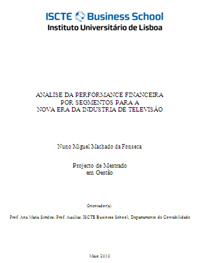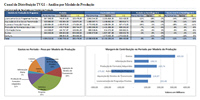 | |||||||||||||
| |||||||||||||
|
|
6 - Conclusions 6.1. Paper Conclusions The answer for the television industry future is somewhere between the new "active" TV and the video distribution over multiple platforms. Despite the expressive video consumption through the computer or mobile phone, TV equipment will continue, in the near future, to be the main consumer equipment. It is connected to the network and it allows access to an endless world of contents. The new "active" TV equipment will also allow interaction not only between the users and their social networks but also with the television broadcaster, who can bring much more than a passive video consumption, taking advantage of interactive services and applications with access to more multimedia content. There will be various consuming equipments, multiple platforms, several ways of distribution and consumption. Through broadcast, VOD or any other distribution channel, contents will make the difference. The television industry must learn to adapt its contents to the new reality and to suit the characteristics of each equipment, distribution channel and way of consumption. The fragmentation of the audience will be a reality. Therefore, it will be essential to be present in various platforms where consumers and advertisers want to be. The technology can not survive without contents. With quality contents and trusted brands, the television industry will present a competitive advantage to succeed in the new environment. The television end has been often equated. However, the distribution channel should not be confused with the contents. Contents connect people to the TV and it does not matter if arriving by air or cable. The audience motivation is in their interest on the contents and television companies have decades of expertise producing of entertainment and news. They also have the ability and the experience to make social relevant events, capable of reaching millions, such as, for instance, sports, political or social events. The TV companies have the ability to influence society and they themselves create events that attract audiences and which become socially and culturally relevant. Among these axes, television companies will be able to continue their path It may not be through the TV equipment; it may one day even be called a different name than television, but TV companies are well positioned to continue bringing entertainment and news to the consumer. With the beginning of television, many predicted the end of radio and cinema. Many decades later, they still persist. They have changed their contents and they have adapted themselves to the new environment. The new era of television multiplies the complexity of the business managing. It will be necessary to distribute through various channels, to evaluate different business models, to deal with various ways of measuring audiences, to create new forms of advertising and of obtaining income. The expenditure control, the efficiency and effectiveness in operations to obtain income are key factors in this business. To achieve these goals, television companies will need the right information in the right time and they will also need to pay attention to the relevant kpi's to act and decide. The television industry has had slow evolution in management concepts and models. It lived many years comfortably in the shadow of broadcasting license.However, this failed to present itself as a competitive advantage, leaving the consumer the chance of, for example,zapping between broadcasting channels and others issued over Internet to which the new TV equipment will have direct access. Identified and presented the new context, this paper proposes a new model that suggests a companies reorganization, removing the focus from traditional broadcasting channel and placing it in the contents. Focused on the broadcast, channel companies will not be able to respond to the changing market demands. This study tries to identify the main business critical analysis axis which can reveal the sources of value creation or destruction and which can point out solutions to the income and expenses allocation and recognition, with the aim of systematizing a conceptual framework that forms the basis for a model assessment of financial performance by segment, capable of meeting the challenges of the new era of the television industry. For the evaluation of financial performance, it is proposed the residual income (MCR) as a method for discharging the financial value generated for the business (assuming the deduction of capital cost) by the responsibility centers and the contribution margin (MC) for the remaining segments without responsibility over economic assets. In this new environment, replete with new variables, the management control must play a key role in the management support. It must assume responsibility for the navigation panel on the business, defining and controlling the relevant KPI's to the strategy implementation and goals achievement. As a result of implementing the proposed model, a reporting model is presented in this paper Appendix, which aims to illustrate a navigation panel suitable to meet the information needs of the industry. 6.2. Constraints and opportunities for future research The choice and scope of this study point it to the future. Ultimately, the depth of each of the discussed topics is limited. Topics such as the programs accounting treatment or the management control in television could be a specific target of analysis and study. However, these issues were addressed to as an introduction of its major aspects, since they are considered to be fundamental components to the development and understanding of the proposed model. To improve management information and business efficiency, concepts such as internal transfer prices (ITP) and activity-based costing (ABC) are assumed to be relevant for a future study. This work could also form the basis to the implementation of a business intelligence solution (BI). To design a BI solution which can truly add value to the management information will require it to be based on the business critical value creation axis and to be aligned with the company strategy. A BI solution without a previous study (similar to the one presented on this paper) or without an implementation of the necessary changes in the accounting management model, could result in a mere set of maps unlinked with the relevant dimensions and segments of the business and without real strategic interest. The model is globally oriented to the companies on the broadcasting TV business. As a generic model, it does not meet the specific needs of a business situation for which an assessment would be needed. To achieve its objectives, the model of management control must be adapted not only from company to company but also over time. To predict television industry future was an opportunity and a challenge and, just like the future of any business, it will always be an unfinished and incomplete study in which it is fundamental to imagine the future and to assess the opportunities and the threats. |
|
|||||||||||
nunofonseca.com - All rights reserved.


